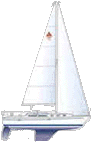|
FAQ: Backstay Tensioners
| Has
anyone installed a backstay tensioner on a C34? We're considering
it, and I'd like to hear some informed opinions.
Please Note: Forestay and backstay too short Yup, I installed one. It consisted of one of those tensioner plate assemblies, the kind with 5 sheaves between two stainless steel plates. The split backstay rides on the inside of the upper 4 sheaves, and the lowest (fifth) sheave is used for the tensioning tackle. The tensioning tackle was a 3:1 block/tackle arrangement, pulling on a 6 x 19 wire rope attached via nicropressed sleeves and thimbles. To provide for attachments points at the bottom end of the block and tackle, and for the far end of the wire rope, I replaced the clevis pins at the bottoms of the backstay with large D shackles, whose pins were equal to the diameter of the original clevis pins. Well, they weren't precisely 'equal', I had to slightly drill out the backstay fittings to clear the pins, but only a little bit. The block/tackle and far end of the wire rope attached to the D shackles with snap shackles, so I could pull the whole thing off quickly in case I needed an emergency block & tackle somewhere. It worked well, although it took a few shots of silicone spray on the sheaves to keep it from squeaking loudly when adjusted (Norm Bernstein).
What are the recommended tensionings for the backstay adjuster? According to a May, 1990 article in Mainsheet, you should consider the following tensionings:
Important: The opinions expressed here are those of the individual contributors to this page, and not those of the Catalina 34 National Association or Catalina Yachts, Inc. Additionally, this material has not been reviewed by Catalina Yachts, Inc. for technical accuracy. This page's maintainer cannot guarantee the accuracy of this information or the desirability of suggested modifications or upgrades. Please obtain assistance from a competent marine mechanic or boatyard prior to making any significant modifications to your vessel. |
